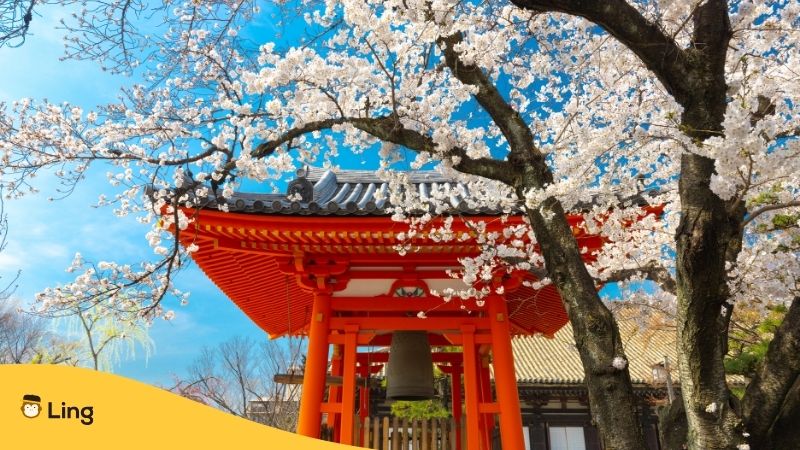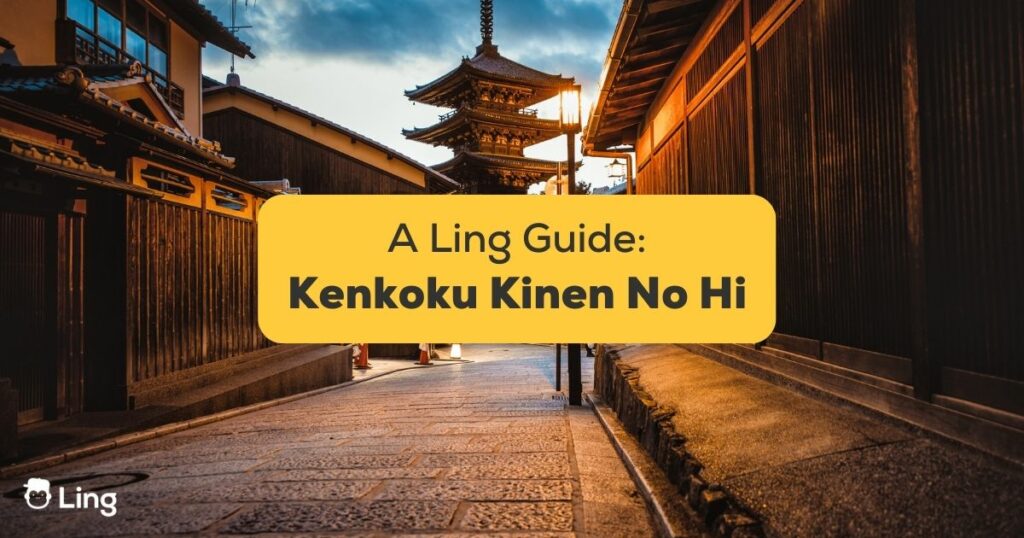Ever heard of Kenkoku Kinen No Hi (建国 記念 の 日)? Every February 11th, the Japanese people put down their high-tech gadgets and get back in touch with ancient traditions on this public holiday. Why, you ask? It’s a time to remember the time when the first Emperor of Japan was crowned, thus being the beginning of Japan.
But this day isn’t just some fusty history lesson…
If you think Japanese culture is all about anime and gadgets, this holiday will show you what truly anchors the national spirit remembrance of the past. Will you be one of the fortunate foreigners to witness Kenkoku Kinen No Hi in Japan? If so, then be sure to read this comprehensive guide. Oh, and I’ll also clue you in on some useful Japanese phrases to help you enjoy this holiday like a local.
Ready? Let’s begin!
Table of Contents

What Is Kenkoku Kinen No Hi?
Kenkoku (建国) translates to “founding of a nation.” Kinen (記念) means “commemoration,” no (の) is a possessive particle similar to “of,” and hi (日) means “day.” So all together, Kenkoku Kinen No Hi translates loosely into “National Foundation Day” in English.
This national holiday was first celebrated during the Meiji Era in 1872 as Kigensetsu (紀元節). It was then known as Empire Day (紀元節) until being abolished after World War II. Finally, in 1966, it was re-established as Kenkoku Kinen No Hi to commemorate the founding of the nation.
Unlike independence days in many other countries, Japan’s Kenkoku Kinen No Hi (建国 記念 の 日) or National Foundation Day commemorates the crowning of the first Japanese Emperor, Jimmu, on February 11th, 660 BC, rather than any modern establishment of the nation. For the Japanese people, Emperor Jimmu’s ascent to god given leadership represents the seminal origins of Japanese culture and history.
How To Celebrate Japan’s National Foundation Day?
Just like in most of the national holidays, you’ll notice many businesses, schools, and government offices closed on this day. While overt displays of patriotism are muted compared to the large celebrations of the past, you may spot more Japanese flags flying to note the occasion.
There are still events held nationwide, like political lectures and small gatherings, to discuss the role of the Emperor system in modern Japan. Various shrines also host festivals featuring parades, drumming, and paying respect to legendary ancestors who shaped the country.
So while celebrations are now more understated, National Foundation Day offers visitors a window into how Japanese culture reveres its long heritage. You can commemorate the holiday by observing commemorations, sampling seasonal dishes, and gaining an appreciation for the history behind this day.

Japanese Vocabulary For The National Foundation Day
Want to impress your Japanese friends or participate in celebrations on February 11th? Here are some key terms and phrases to know related to Kenkoku Kinen No Hi!
Shukujitsu (祝日)
Shukujitsu translates to “holiday” in English. You’ll see signs with this term indicating that February 11th is an official holiday in Japan. Government offices, banks, schools, and many businesses will be 休み (yasumi – closed) on Kenkoku Kinen No Hi.
Kenkoku (建国)
Kenkoku means “founding of a nation” in Japanese. On National Foundation Day, Japan commemorates its mythical beginnings and honoring the kenkoku of the country by Emperor Jimmu in 660 BC according to legend.
Jinmu Tennō (神武天皇)
Jinmu Tennō refers to Emperor Jimmu, the first legendary Emperor who established the Japanese empire thousands of years in the past. He is honored as the shodai tennō (初代天皇) – literally translating to “first generation heavenly emperor.” Emperor Jimmu’s divine coronation and ascent to the throne is the pivotal event memorialized by Kenkoku Kinen No Hi each year.
Kigensetsu (紀元節)
Kigensetsu translates loosely to “Empire Day” and was the first name for National Foundation Day during the 1872 Meiji era in Japan. After being briefly abolished following World War II, it was established again in 1966 as Kenkoku Kinenbi (建国記念日)– changed to literally mean “Nation Founding Memorial Day.”
Nihon no Rekishi (日本の歴史)
Rekishi means “history” in Japanese. Nihon no rekishi refers specifically to Japanese history, which is considered to begin on the date honored by this national holiday – the ascension of the first Emperor Jimmu in 660 BC.
Sokui (即位)
Sokui translates to “coronation” and refers to Emperor Jimmu’s appointment as the leader of Japan in 660 BC, establishing the imperial line that continues today. This first legendary sokui is dramatized in parades and ceremonies on Kenkoku Kinen No Hi.
Nihon Shoki (日本書紀)
The Nihon Shoki is one of Japan’s oldest historical literary sources documenting ancient myths and legends leading up to the founding of Japan under Emperor Jimmu. It provides context on the seminal events celebrated on National Foundation Day.
Ready To Connect With Japanese People?
As you can see, Japan’s National Foundation Day offers unique opportunities to experience the living heritage behind this great island nation. By understanding traditions from visiting shrines to sampling seasonal delicacies, you’ll get insight into the origins anchoring the Japanese spirit to this day.
And why not continue your cultural journey by picking up essential Japanese phrases? With the Ling app, you can build language skills tailored to your exact interests – including basics for dining, directions, or discussing Japanese history from ancient conquerors to modern innovation.
Don’t just skim the surface of anime and J-pop. Deepen your connection through language across the generations of Japanese culture and society with the Ling app today!


































































